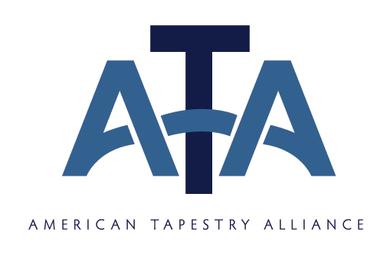ATA’s Mentoring Program
ATA’s Mentoring Program offers weaver-to-weaver instruction. Mentors and mentees are matched according to the mentee’s interests. Both beginning and experienced weavers will benefit from the Mentoring Program. Suggested areas of tapestry weaving instruction below are a general guide. The mentee must be an ATA Circle member. For information about applying, contact Linda Disosway, Program Chair, mentoring(at)americantapestryalliance.org. Please note that due to internet safety concerns, we no longer provide direct links to emails. Please type in the address in your email message substituting the (at) with the ampersand symbol.
Student’s Responsibilities
- A six-month time commitment (could be extended by mutual agreement);
- Define the area of study;
- Prepare a list of realistic goals and objectives to complete in six months;
- Describe any finished project that you hope to complete;
- Propose a timetable for submitting samples, drawings, etc.;
- Pay for any expenses incurred during the program; and
- Submit a final report to the ATA Mentoring Committee.
Mentor’s Responsibilities
- A six-month time commitment (could be extended by mutual agreement);
- Help the student set realistic goals for this six-month time frame;
- Provide direction, support, and expertise as the student requires;
- Recommend additional sources for information and tapestry workshops;
- Evaluate progress during the course of study by critique; and
- Submit a final report to the ATA Mentoring Committee.
When considering applying, these are the distinctions between beginner, intermediate and advanced mentees to use.
Basic Tapestry Weaving Instruction
An experienced tapestry weaver guides the student during a six-month instructional period. Students are expected to be self-motivated and dedicated in their selected study focus area. The student provides supplies and yarn along with covering incidental expenses. Before seeking a mentor you should have had some experience with tapestry so that you will be able ask for help in specific areas. Books and YouTube videos can offer instruction for a small project or two.
- Warping a Tapestry Loom
- Yarn Selection
- Basic Tapestry Techniques
- Beginning Cartoon Development
Intermediate/Advanced Tapestry Weaving Instruction
An experienced tapestry weaver guides and mentors the student during a six to twelve month instructional period. Students are expected to be self-motivated and dedicated in their selected study focus area. The student provides supplies and yarn along with covering incidental expenses. Each student selects one or more focus areas from the following categories:
Loom Preparation
- Discuss options regarding important characteristics in a loom
- Considerations of warp sett and warp size
Advanced Tapestry Techniques
- Slit Tapestry
- Shape Building
- Eccentric Weave
- Wedge Weave
- Shaped tapestry
- 3-dimensional tapestry
- Inlay
- Twining
- Soumak
- Incorporating other materials, e.g. beads, feathers into tapestry weaving
- Color blending on the bobbin
- Hachure and Hatching
Design
- 2-dimensional design
- Designing with a computer
- Collage
- Color Theory
- Cartoon Development
Tapestry Finishing Techniques
- Slits, Hems and Steaming
- Preparing a tapestry for hanging
- Mounting small tapestries
Dyeing
Presentation
- Photographing your tapestry
- Digital image prep
Tapestry History
Other Personalized Area of Study
For information about applying, contact Linda Disosway, Program Chair, mentoring(at)americantapestryalliance.org.
ATA’s Mentoring Program is available because ATA members graciously volunteer their time to help others improve their tapestry weaving skills. We expect mentors and mentees to be respectful of time commitments and mutually agreed-upon milestones and program deliverables. Any participant not honoring his or her commitments may lose a future opportunity to participate in ATA’s Mentoring Program.
